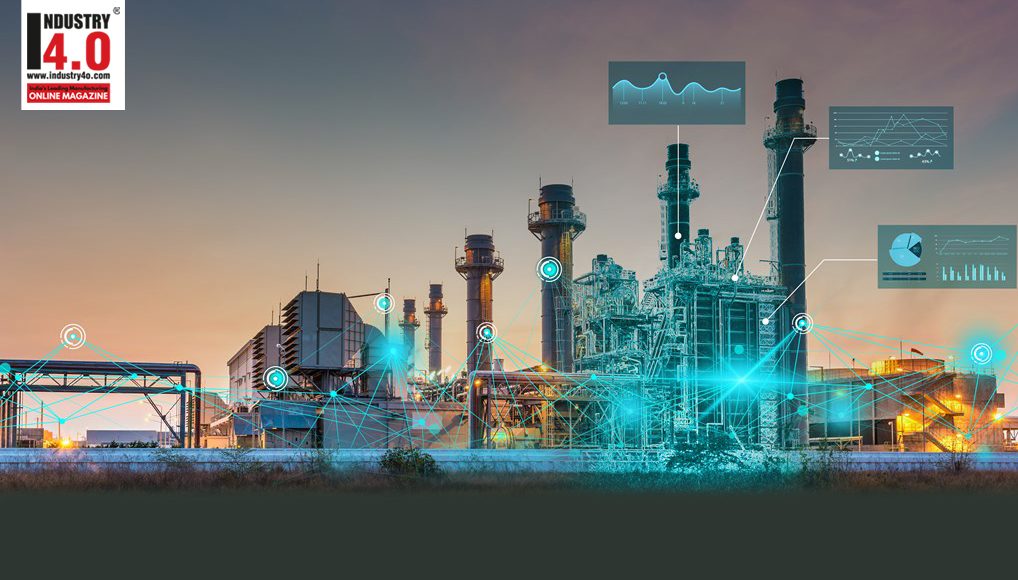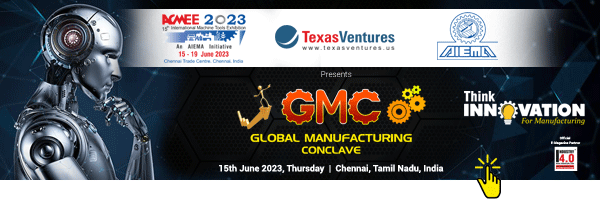Digital Twin – Plant Life Cycle Management
PREMISE:
In 2020, the digital twin market was valued at USD 3.1 billion, it is estimated to grow sharply to 48 billion in next 5 years, which is why, we can see lot of traction and messaging by various solution providers, vendors in jumping this bandwagon.
However, there is a lot of ambiguity in the understanding of Digital Twin, leading to mis-alignment in between purpose or business problem that the industry leaders are trying to address.
Before we proceed further, lets steer clear of some common myths about Digital Twin:
- It is NOT ONE STOP solution to digital transformation journey
- It is NOT standalone simulation software
- It is NOT a plug and play Cloud Application
- It is NOT Artificial Intelligent solution that can replace human intelligence (NOT YET!)
Digital Twin has broader context-based definition, especially for a process industry. ” It is a virtual replica of existing physical asset(s), that has ability to convert the data into information which can further be used for specific purposes,” now depending on the context the definition needs to be elaborated and customized.
Digital Twin in its essence consolidates the information of the plant; which can be used for shorter production cycles, increased product output, flexibility in production, and more efficient quality assessment; operator training; further more by utilizing the self-learning machine learning algorithms (Unsupervised Training of programs from historical datasets), there are possibilities to realize self-optimizing plants.
BRIEF LOOK AT DIGITAL TWIN FACETS AT VARIOUS STAGE PLANT LIFE CYCLE
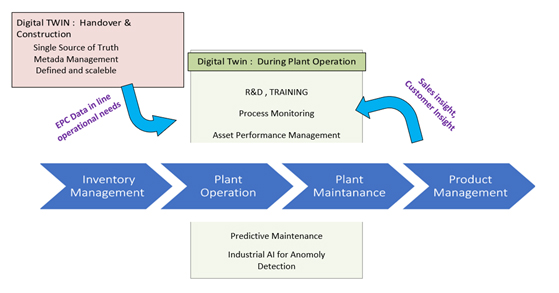
DIGITAL TWIN TARGETED FOR CAPITAL PROJECT HANDOVER:
Under this, Engineering & Construction contractors should provide ability to maintain single source of truth not only during project execution but during operations & maintenance of the plant;
Key features of such a Digital Twin:
- Consistent data creation of Assets (Naming Conventions, Tagged Metadata and Symbology across consultants & Plant Areas)
- Cloud based or Hosted consolidation of data from all contractors
- Defined connectors to existing plant IT Architecture Ex; integration with Enterprise resource tools, connectors to existing tools like historians, APC and DCS information.
- Interface to project management tools already available with Owner Operators
Such a Digital Twin, while implementing gives insights in capital project execution but also could connect to the existing information sources of plant operation and maintenance.
DIGITAL TWIN TARGETED FOR ASSET PERFORMANCE; it means that the Digital Twin should provide ability to simulate performance parameters, enable owners’ operators, predict the performance, and ensure recommendations are available for the users.
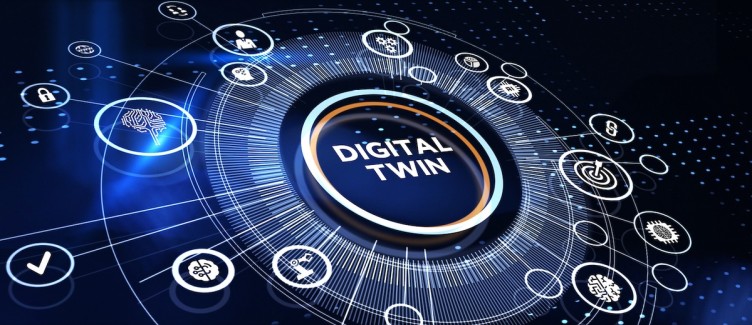
Key Features of such Digital Twin
- System collects information from the assets via sensors
- System comes with predefined trained machine learning model of ideal performance parameters
- Collected information is fed to the trained model within the system
- Based on outlier is detection, system initiates a condition-based maintenance action
- Predictive Machine learning models within the system enable scheduled maintenance
- Deep learning models within the system enable prescriptive maintenance
- Advance neural networks with self-learning models can further take this is asset performance into Autonomous zone for preventive actions.
DIGITAL TWIN TARGETED FOR PROCESS MONITORING:
The Digital Twin should be able to read process operating parameters and enable users to simulate the possible outcomes, while giving the ability to take actions, based on targeted business outcome;
- System based on a first principles model originally used for process simulation, embedded with advanced machine learning models for analysis of critical operating parameters for monitoring of the process.
- System collects data from the historians and existing controls systems and is part of existing business process workflow
- Hence although uses simulation as base for analysis, it captures real time scenario to predict the outcome that can be used for
- Predictive / Preventive actions – Alert Operators for specific actions
- Autonomous – take actions based standard operating parameters
Above highlighted are broad level industry requirements and solution expected by the owner operators, however there is as of now, there is seems to be no direct integration between the various Digital Twin needs and solutions.
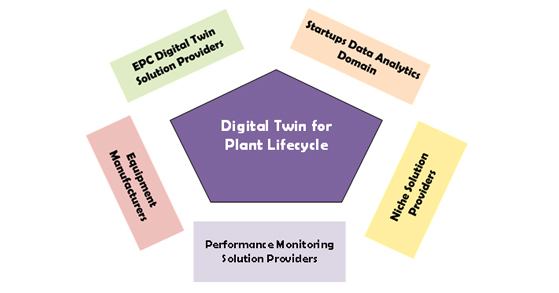
EQUIPMENT MANUFACTURERS:
Define the Digital twin through their product lens and they deal with effective utilization of their virtual model of the equipment:
- Increased reliability of equipment and production lines
- Reduced downtime, improved performance, or productivity
PERFORMANCE SOLUTION PROVIDERS:
These are enterprise technology providers that are deeply involved process designing and operation of the plants and have deployed their legacy systems already. They are upgrading of their software; that utilizes Artificial Intelligence and provide: .
- Process Anomaly detections
- Self-diagnosing plants
- What -if scenarios of process operations
NICHE SOLUTION PROVIDERS:
These are Big Tech companies, Startups that are foraying into this bandwagon, they have the technical skills with little or no domain specific skills. However, they might of latest technological skills and offering solutions based specific point solutions, such as :
- Data Integration
- Real time Process Monitoring
- Advance Analytics on Process Conditions
- Operation excellence Tracking / Insight reporting
START-UPS IN DATA ANALYTICS DOMAIN:
These are companies; that are coming with latest products of Digital Twins, which give specific and point solution to meet specific problems of owner operators.
- Remote Process Monitor
- Integration and predictive maintenance of process
- Health Safety and Environment Twins for Training
EPC DIGITAL TWIN PROVIDERS:
These are established software vendors in EPC domain focusing on data consolidation and project handover solutions. The product features include the consolidation of information from multiple EPC contractors at the same time configuring flexibility of their products to integration of plant operation tools. Which provide:
- Consolidation and consistent information handover
- Connection to plant enterprise tools for asset information management
- Document collection and workflow management
With variety of solution and problems statements in the area of Digital Twin ; The question remains how best, owner operator can define their problem area and how best enterprise implementation can be planned at the grass root level by the owner operators
Recommendation:
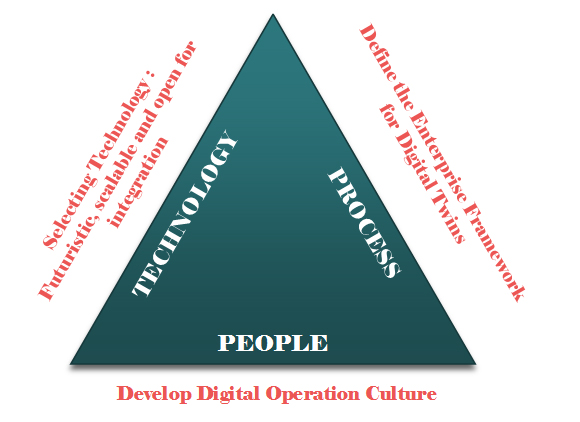
Digital Operation Culture in process industries: selecting right technology, investing right, and identify right business problem is foundation for a great start but unless industry starts building the right culture; where conversion of data into information and targeting insight is valued, Digital Twin implementation cannot be successful. Hence build right skills and right people engaged in implementation of the Digital Twin.
Digital Twin framework: Enterprise Digital Twin Framework based on the different facets fo Digital Twin available, being researched up on by the technology providers and researchers will help in fitting different point solutions of digital twins into overall strategy. This overall framework can be guiding principal while selecting and implementing Digital Twins.
Selecting Technology: owner operator over the period may end up with multiple Digital Twins ; each digital twin must have integration capabilities and must fit into enterprise framework. Leading cloud solution providers offer performance models for data collection, storage, and processing, they also have advanced machine learning algorithms and deployment kits readily available for implementation. Hence Digital Twins should be able to utilize this advance technology based on use case. Digital twins should be open to integration are fundamental to selection.
About the Author :
 Mr. Sameer Shirur, PMP
Mr. Sameer Shirur, PMP
Group Manager – IT Delivery Management
Burns & McDonnell India.
Mr. Sameer Shirur, experienced professional with more than 18 years experience in Process Industry and Petrochemical sector ; Driving Innovation and digital technology for Engg , procurement and construction business cases is his forte . evaluating and adopting along with propagation of Industry4.0 technologies for the chemical industry is an area of interest. Currently Manages one of industry specific think tanks `Digital Transformation – EPC and Associated Industries on Linkedin”.
Worked on transformational projects for large scale companies and having managed large teams that drive these initiatives. Certified PMP Professional, Organisational Transformational certificates along with Data Science & Artificial Intelligence Certifications.
Project Management, Operation Management, IT Strategy and Digital Transformation are hands on experiences, bringing industry firsts with careful evaluations and most importantly people management what excites him.
Mr. Sameer Shirur is Bestowed with the following Licenses & Certifications :
https://www.linkedin.com/in/sa
Mr. Sameer Shirur can be contacted at :
Mobile :+9199209 98049 | E-mail | LinkedIn | Twitter

